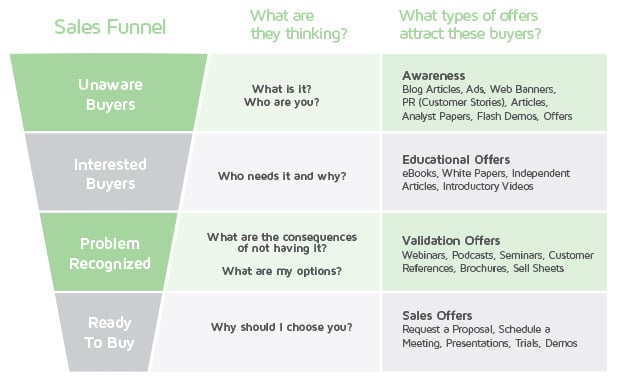
The sales funnel describes the sales process from initial contact to final sale. So where does marketing come into place? The job of marketing is to attract qualified prospects and provide the information needed to move them down the funnel, increasing the probability of closing a sale.
More than 80% of buyers start their search process online, according to GE Capital Retail Bank’s second annual Major Purchase Shopper Study; thefore this article will focus on the effectiveness of your online sales funnel. This article will also provide some action items to help you create or redefine your own online sales funnel.
Let's start with a visual depiction of the sales funnel. Then, we’ll examine each stage in more detail.

Stage 1: Unaware Buyers
What’s Going On? During the awareness phase, the prospect recognizes that he or she has a problem but is not quite sure what it is yet. Prospects in this phase use keywords that describe the problem, but they don't fully understand their options or solutions. They are looking to be educated on the particular topic. At this stage, the prospect's commitment is low.
What Can You Do? At this stage of the game, your organization should be providing content that educates prospects and addresses their problems. This is your opportunity to create awareness about your organization in the prospect's eyes. Create blogs that talk about those initial keywords that describe the prospect's problem. In addition, create ads, web banners and press releases. You should avoid salesly language.
 Stage 2: Interested Buyers
Stage 2: Interested Buyers
What’s Going On? At this stage, prospects begin to understand what options and solutions are available. They have more educated questions and are now actively curious about what your product — or other similar products — can do for them. Individuals in this phase are starting to develop an opinion about how your product could fit into their live.
What Can You Do? This stage presents an opportunity to establish yourself as a thought leader in the industry and differentiate yourself from your competitors. Further educate your prospects by providing relevant how-to articles and videos, e-books, buyers’ guides, industry white papers and events.
 Stage 3: Problem Recognized
Stage 3: Problem Recognized
What’s Going On? Leads in this phase are establishing their buying criteria: price, quality, etc. They are prioritizing what's most important in a solution and don't want to be missing anything! Their commitment is medium to high.
What Can You Do? Highlight your competitive advantages by pointing out the consequences of not having them. Create articles such as "10 Reasons...", "Things You Must Know...", "Questions to Ask...", and "How to Buy...." You can also provide relevant webinars, podcasts, case studies and checklists.
 Stage 4: Ready to Buy
Stage 4: Ready to Buy
What’s Going On? At this stage, leads are evaluating vendors based on their buying criteria, and this is your opportunity to justify why should they choose you. They will most likely narrow down their list to the top three to five vendors. They are comparing and looking for trials, demos and consultations. Their commitment at this stage is high.
What Can You Do? Create presentations, topic sheets, product white papers, customer testimonials and references. In addition, offer free trials, consultations and competitive intelligence.
There’s a common theme to this approach to the sales funnel, and it’s one you should always practice: Control the message. You have the opportunity to guide potential customers through the sales funnel. Keep in mind that the sales funnel isn’t so much about pushing your product as about helping to educate customers.
After reading this article, did you find opportunities for improvement in your sales funnel? We welcome your opinions in the comments below!









